#aramaic targums
Text
IOTS 2024 Call for Papers
Last time in Amsterdam was with Mack and we watched Celtic v. Ajax. He was not happy with the outcome (his club is called Celtic, it was 0-4 to Ajax).
I will be proposing a paper for IOTS and/or iSBL. I hope to see some of you in Amsterdam this summer! I intend to take in an Ajax match, if possible.
1th International Organization for Targumic Studies
Call for Papers
It is a pleasure for the…
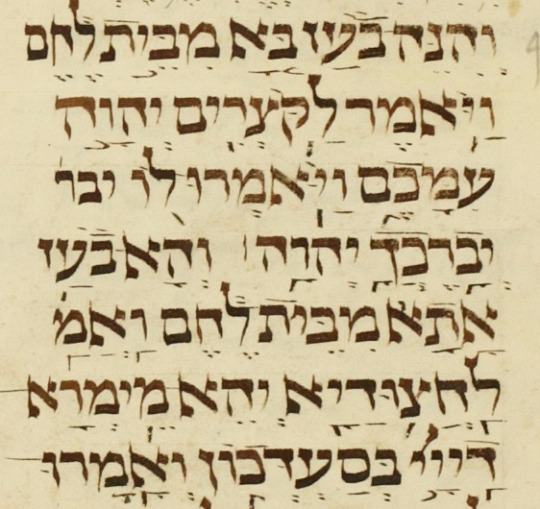
View On WordPress
0 notes
Text
I like this portion of Psalm 91:
You will not fear the terror of night, nor the arrow that flies by day, nor the pestilence that stalks in the darkness, nor the plague that destroys at midday.
BUT I think the Aramaic Targum of Psalm 91 is worth noting ‼️‼️‼️
Be not afraid of the terror of demons who walk at night, of the arrow of the angel of death that he looses during the day; Of the death that walks in darkness, of the band of demons that attacks at noon.
84 notes
·
View notes
Text
ok here's another explainer post explaining the aramaic language very basically:
what is aramaic?
to paraphrase wikipedia, aramaic is a northwest semitic language that the arameans (where the name comes from) spread somehow a really long time ago. it since became the prestige language in a bunch of empires like the neo-assyrian empire. although its place was eventually taken by other languges, it's still preserved to this day in many different forms.
nowadays, "aramaic" is a broad label for a very diverse dialect continuum, sort of like “arabic”, “kurdish”, “persian”, or “hindustani". in other words, it's like if we referred to all the languages in italy, including older ones like the latin spoken in roman times, collectively as “latin”. (this isn’t too far off how some governments think of minority languages actually, but that’s beside the point.)
how is aramaic related to other semitic languages?
being a northwest semitic language, aramaic is a sister of the caananite languages (making it an aunt of hebrew and phonecian), a cousin of arabic, and the second cousin of the ethio-semitic languages (making it the second cousin once removed of ge'ez). if you need a comparison, english is the second cousin of dutch.
how is aramaic used today?
specific sorts of aramaic are used today for religious and vernacular purposes. some religious aramaic:
classical syriac, which developed from eastern aramaic, is the liturgical language of the christian east and west syriac rites, each using their own dialect. classical syriac was also historically used as a literary language.
mandaic has a similar history, and is now used in the liturgy of the mandaean faith of the ethnoreligious mandaean people.
targumic aramaic refers to the archaic aramaic used in several antique translations of the tanakh from biblical hebrew into aramaic. the talmud is also in two different versions of older aramaic as well as mishnaic hebrew. these are used for study in general by all jews, and yemenite jews still use the targumim liturgically.
samaritans also have their own aramaic which is similar in form and use the jewish one.
all of these forms of aramaic are different evolutions in their own right - influencing and possibly descending directly from newer aramaic forms. we don’t know exactly what came from where, and linguists tend not to always be exactly right when figuring it out (which is why “vulgar latin” was a thing people thought was real for a while).
the vernacular aramaic spoken today are the neo-aramaic languages, which represent the latest vernacular evolutions of aramaic from late medieval times. most of the neo-aramaic varieties spoken today are central and northeastern neo-aramaic, which stem from eastern aramaic, and most of the speakers are ethnic assyrians. smaller communities speaking the only surviving variety of neo-aramaic which came from western aramaic exist in a few villages along the anti-lebanon mountains (like the village of maaloula in syria). a mostly aging community of judeo-aramaic speakers live in palestine.
a map of the homes of the living neo-aramaic varieties, which doesn't necessarily reflect where each variety is spoken (the labels are a bit confusing - pretend syriac/aramaic say "neo-aramaic", and specifically that "western syriac" says "central neo-aramaic"):

here's a map of the "larger" judeo-aramaic varieties by 1948 (judeo-aramaic was generally spoken in these areas but "smaller" dialects may not be shown or named):

i should say that not all speakers of these types of aramaic agree with some of the names linguists have ascribed what they speak. for example, "turoyo" speakers refer to their language as "surayt". linguists also gave the name "aromay" to the neo-aramaic spoken in maaloula, but the speakers themselves refer to their language as "siryon". "neo-aramaic" is itself an exonym. this part of the world is in general not written about a whole lot, and when it is, it's not always with the input of the people who are from there.
another interesting thing about the names is that, while christians tend to call it some form of s-y-r (sureth, suryat, siryon, etc, ie syriac), jews tended to call it some variation of either "our language", "jewish", or "targumic". you can find this in some other jewish languages/dialects/ethnolects.
christian/assyrian varieties seem to be a lot more widespread than jewish ones. what's that about?
there's a lot more christians in the world than there are jews.
what do you mean by “jewish” neo-aramaic, anyways?
"jewish neo-aramaic" is a term linguists gave to the many languages jews in those regions on the map spoke which are descendants of araaic. like the other types of neo-aramaic, judeo-aramaic is not one, all-encompassing language, but multiple languages that all happen to be spoken by jews. variations in regional languages can be as small as from town to town all over the world, communities with some form of separation may have their own dialects, religion has often had an effect on where you lived in the me historically, and this part of the world was known to be a place you fled to if you didn't like whatever government was in power (you could call it the "mashriq's appalacia"), hence, jewish neo-aramaic[s].
the degree of mutual intelligibility between jewish neo-aramaic types and other neo-aramaic types varies - some are unintelligible to other kinds despite the two being in the same city/town, others are exactly the same save for the stress in a word being on different syllables. differences don't mean jews and other aramaic-speakers couldn't have spoken each other's dialects, understood each other, or gotten influence from one another in addition to other contact languages. there was usually some other sort of medium they were using, be it arabic, kurdish, turkish, or a "neutral" aramaic. it's kind of like an amplified version of the differences between different arabic dialects in that way.
the association of "jewish language" usually brings about the questions of loanwords from hebrew or targumic (which many jewish neo-aramaics did have), mutual intelligibility with the "standard" form of a language, or social isolation (such as in yiddish, which itself wasn't even isolated, quite the contrary in fact), but that isn't what makes a jewish variation of a language "jewish". it's more that some variation of a language was used by jews in a specific context. (sort of like how the class differences in different english accents in the uk don't actually render different types of british english unintelligible to one another. or even how i'd probably avoid talking to my mom about my favorite video game characters because she has no idea what a "jun oda" is, but i can talk to her about other things.)
what about muslims? did/do they speak aramaic?
you can't switch the language you speak overnight, so yes, muslims who lived in places where aramaic was still widely spoken spoke aramaic instead of and even in addition to other languages in the past. also, that someone stopped speaking aramaic doesn't necessarily mean it's gone forever - not only are muslims thought to have retained an understanding of aramaic their non-muslim neighbors may've spoken even if they didn't speak it themselves, but aramaic influenced some of today's regional arabic dialects. (more on that later.) the association of neo-aramaic with non-muslims is actually rather recent in that regard.
as for aramaic-speaking muslims today, most of the the aramaic-speakers in the speaking communities on the anti-lebanon mountains i talked about earlier are muslim. the communities are close-knit, and the isolation helps.
and what about mandaeans and samaritans? do they have a vernacular aramaic?
not only do mandaeans have one - neo-mandaic - but it's the only surviving pre-medieval vernacular aramaic dialect. (it’s the only vernacular aramaic that isn’t a “neo”.)
i’m sure samaritans also had their own vernacular aramaic before switching to arabic (which they spoke before the occupation happened). western vernacular aramaic usually didn’t last.
how come? does it have anything to do with most neo-aramaic being central and northeastern, like the map showed?
it does. differences in geography (east med = more densely populated; north mesopotamia = less densely populated and more mountains), which pre-arab and post-jesus empires ruled where (byzantines ended up with most of the places west aramaic was spoken), and how much those empires cared about aramaic resulted in arabic taking over as the vernacular in pretty much all the western areas except in more rural places, while more of the generally more isolated eastern aramaic-speaking communities lasted. in general, the more urban and shami you were, the shorter time it took you to adopt arabic.
also, classical syriac having a lasting literary history and barely any western aramaic languages being able to say the same contributed to what future generations were able to pick up on. the greek-influenced christians in those west armaic speaking areas had a habit of burning aramaic-language manuscripts because of church fandom drama. there's some revival efforts in traditionally western neo-aramaic speaking communities, though in places like palestine and lebanon, these may take on a certain political dimension that they don't have elsewhere.
what else differentiates different types of aramaic?
the same things that differentiate different versions of other dialect continuums: languages speakers spoke before, the passage of time, different neighboring languages, and geographic distance (“western”, “eastern”) bring about new quirks in pronunciation/phrasing/grammar/loanwords. this is pretty heavy stuff, so if you want the specifics, i recommend looking into the timeline of a specific aramaic language.
is western neo-aramaic closer to what jesus spoke? is it more authentic?
in theory, sure - he would've spoken a western vernacular variety called galilean jewish aramaic specifically. in reality, this question is like asking if british english is more authentic to the english shakespeare spoke. aramaic in general and the world as a whole have changed so much from the time jesus would've lived. he would understand any of today's aramaic just as much as shakespeare would understand the english spoken on tiktok.
how's mutual intelligibility?
it can vary significantly or not at all, but the same aramaic "basis" is still there in all forms. i'd wager it's about the same level of differences you'd find between different romance languages.
here's some transliterations of the lord's prayer (our father who art in heaven etc) in western neo-aramaic, suryat/turoyo, the eastern dialect of classical syriac, and (for some reason) hebrew courtesy of wikipedia to show a few differences:

or this one, of the assyrian and jewish urmia dialects:

did aramaic influence other languages at all?
like i implied in the second question, all the semitic languages are super close, and a lot of them have cognates or similar words/phrases. in that sense, it may not be as easy to say what definitively came from where, but that doesn't mean it's impossible.
before levantine and mesopotamian arabic speakers spoke arabic, aramaic was the lingua franca in the areas where they lived. aramaic forms a substrate in all of these types of arabic in loanwords, some pronunciation, and a few grammatical features. aramaic influence is more significant in certain types, such as in more rural dialects of levantine arabic as well as northern and jewish dialects of mesopotamian arabic, which speaks to how arabic spread in those areas. (i also heard the dialect of arabic marsh arabs speak has a lot of aramaic influence but i couldn't find a good source.) this is a pattern you can find in regional variations of arabic in general, such as the influence of coptic on egyptian arabic.
(arabic in general also has a number of aramaic loanwords, like دفتر (daftar), or "notebook". this word is originally greek but came via aramaic.)
hebrew, being often used together with it in the past (and aramaic eventually supplanting it as a spoken language), has been influenced by it for a while now. aramaic also formed an influence on pretty much all the non-aramaic (since those are already aramaic) jewish languages in a similar way to what happened with levantine/mesopotamian arabic, though hebrew influences jewish languages more than aramaic generally. it also influenced most of the loans in modern hebrew, including the words they made up (like "glida" for "ice cream", which comes from an identical word meaning "ice" or "frost". i don't know if the word "gelato" had anything to do with this as well, but it might as well have.)
aramaic also has influences on kurdish, farsi, armenian, ge'ez, turkish, latin, greek, and probably more that i can't think about right now via loanwords and terms, though they're not as significant. and yes, that latin/greek means we have aramaic-derived words in english, too, such as "messiah", though they're mostly in the form of given names like "matthew" and "peter".
is aramaic endangered? are the other varieties of aramaic extinct?
the religious languages are all in continuous use in one way or another, but not as vernacular with native speakers, so they'd be considered "dead". (this is what hebrew was before its revival.) an "extinct" language is a language that didn't even survive via written records, which some varieties of aramaic (mostly western ones, like i mentioned earlier) are.
as for vernacular aramaic, all of them are endangered - i don't think there's any varieties with over a million speakers, and no varieties are an official language anywhere - but some varieties are safer than others. the ones that are doing the worst right now are probably neo-mandaic (which only has a few thousand native speakers), the jewish neo-aramaic dialects (which can vary from a few thousand to a few hundred to single digit speakers, the one with the most speakers right now is the hulaulá ("jewish") dialect with 10,000 due to most of its speakers coming much later than others (from iran in 1979)), and a handful of christian/assyrian regional dialects (like the one of hertevin).
western neo-aramaic is endangered in the sense that it's the only surviving vernacular western neo-aramaic with a speaking community, but there's 30k speakers as of 2023, so it could be doing worse.
what scripts are used to write aramaic?
it's worth noting that vernacular neo-aramaic everywhere was only passed down orally for generations, and written forms, especially for teaching, are quite recent. also, all the scripts i'm about to mention are right-to-left abjads. that said:
the old aramaic script was used to write it in the past. from a combination of it and paleo-hebrew developed the hebrew script (which used to be called "ktav ashuri", or "assyrian script"), which has been used to write all jewish variations of aramaic since, and is used to write judeo-aramaic today. samaritans use their own script to write in aramaic.
the old aramaic script also birthed the nabataean script (which is the parent of the arabic script) and a few historic persian scripts like the pahlavi script (which gave us the avestan script).
syriac script, in use from the first century, is used to write classical syriac as well as the many varieties of neo-aramaic spoken by christians/assyrians today. the revival efforts in maaloula originally used a very familiar script but eventually switched to the syriac one because that one looked a little too familiar.
the syriac script also developed from the aramaic script. (if you know how to read the hebrew or arabic scripts, see if you can recognize letters below.) there's some variations between the eastern and western syriac scripts (called "maḏnḥāyā" (eastern) and "serṭā" (line) respectively), along with the classical 'esṭrangelā (rounded) script. the two main differences are:
vowel notation - western uses small greek letters (ܓܱ = ga, notice the small A on the bottom), eastern uses an older form (ܓܲ = ga, with a dot above and below). like with other abjads, you won't usually see vowel notations in use at all.
font/shape - you can't see them in unicode, but each have a particular style they're written in. as you can guess from the name, 'estrangela is more "rounded", eastern is generally heavier and conservative in its rendering, and western is more simplified. (the kind used in unicode is 'estrangela.)
some examples, again courtesy of wikipedia:

syriac script also has some descendants. its child, the sogdian script, was used to write the iranian sogdian language, and is the parent of the manichaean aramaic script, the old turkic script (which gave birth to the old hungarian script), and the old uyghur script (which gave birth to the mongolian and manchu scripts).
mandaic also has its own script, the mandaic script. it's another descendant of the aramaic script (maybe via parthian) in use since the 2nd century ce. it's used to write both classical and neo-mandaic. instead of traditional semitic letter names like "aleph", "bet", "gimel", etc, it's known to use its own names, like "a", "ba", "ga", etc. neo-mandaic uses a modified version of the classical script but it's barely written to begin with.
here's a written sample of article 1 of the universal declaration of human rights written in classical mandaic script:

i don't have any familial or religious connection to aramaic, but i'd like to learn it. can i?
after you pick which sort of "aramaic" you wanna learn, i don't see why not. it's not closed or anything. there's probably someone out there who feels differently but that's their problem.
where can i learn [aramaic type], or learn more about it?
i'm trying to find this out myself. the only actual judeo-aramaic learning resource i could find was the mysterious once-a-year class offered by oxford's school of rare jewish languages. that said, here's some resources i know about:
northeast neo-aramaic database project - a database by cambridge of info on different dialects of nena neo-aramaic, including recordings, layouts of the grammar, and comparisons between different dialects.
resources on reddit's language learning sub
two pdfs to make up for that broken first one
šlama.io - focuses on assyrian neo-aramaic (sureth)
surayt.com - resources for surayt
mandaean network - resources on mandaic.
r12a - resources on how different scripts in all languages work, good resource for languages/scripts in general.
if you know any more resources, reply with them to this post and i'll put 'em here.
14 notes
·
View notes
Text




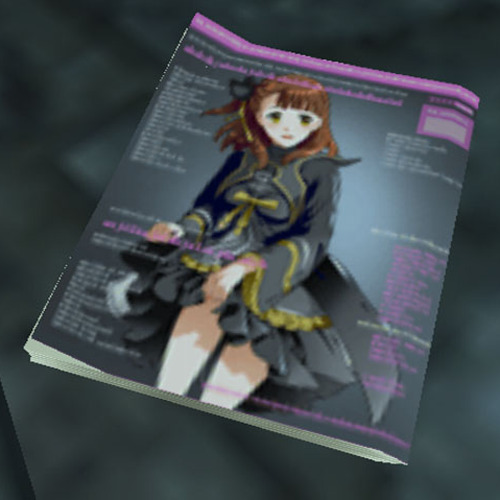

So the Adult Mags boss fight became a recurring thing starting with Wild Arms 3.
In their first appearance they feature the NPC Claudia, whom Melody had disguised herself as in an attempt to seduce Gallows and Clive, which of course notoriously failed. It's not entirely clear what was on the back cover.
In Alter Code F is has the dream demon, Elizabeth on the cover and also the interior pages.
Then for WA4 and 5 they use the same cover art with the Raid Buster enemy on the front?? for some reason, and the Doctor Gob on the back.
Weirdly, they did make an overworld model of the Adult Mag in 5 that doesn't match the one used on the actual enemy model in battle; It features Yulie, from WA4.
It's actually kind of odd that the enemy stuck around, because for WA4 and WA5 there aren't that many magic book enemies, where as they had been kind of a staple of the Wild Arms bestiary in the early games, starting with Cecilia's prologue dungeon being the hidden library. And in fact, I want to kind of trace the history of this family of enemies while we're on the subject...
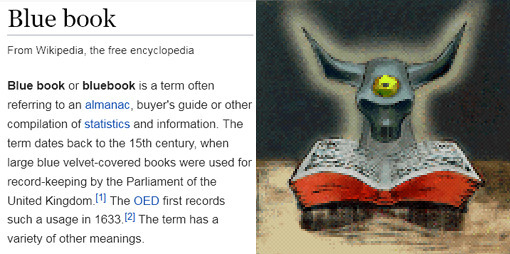


The seminal entry to the bestiary is the Blue Book, found in Cecilia's prologue in the original Wild Arms, and as a sort of throwback, also appears in Lilka's prologue in WA2. Despite the seemingly overly literal name, it's actually a reference to the above pictured style of British almanac.
I like the idea that it's a kind of living magical book, not because it's some cursed grimoire or ancient tome of magic, but just because it's an encyclopedic collection of information that happens to include enough aetheric truth about the nature of magic that it manifests magic itself. It also accounts for why it's such a low level monster, because it's not really a deliberately magical being.
(I had trouble getting a good shot of its front cover in WA5 but I assume it's the same as in 4 and F)
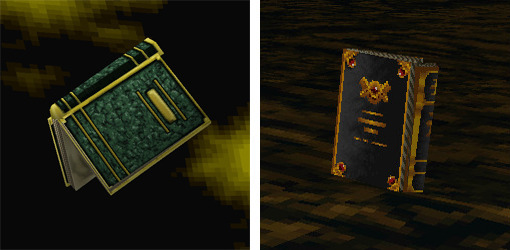
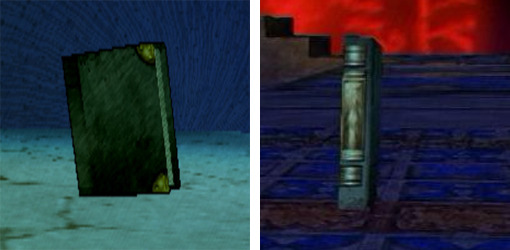
After that the obvious progression in magical books is the Necronomicon itself, famed grimoire of Lovecraftian lore, allegedly written by Abdul Alhazred, "The Mad Arab," whom is of course the namesake of the Wild Arms 1 villain, Alhazad.
It appears consistently as a book bound in black leather with some form of golden trim or clasps. Hard time getting a clear shot of the front cover in 3 or F. They have been variously localized as Necromicon, Necronomic, and actual Necronomicon as less of a translation issue and more a character limit problem.


Perhaps the more surprising addition to this family is the Targum (initially mislocalized as "Talgium") which is a Hebrew term used to refer to the original Aramaic translation of the Tanakh.
For one, it's a really obscure kind of thing to pull for a bunch of Japanese creators, but I kind of love how it isn't some faux-qabal derived grimoire the sort that was popular with Christian occultists of the middle ages, from which a lot of Christianity's fake lore comes from, and from which demonology owes its roots. Instead it's just the idea that this original translation somehow holds power in and of itself. It doesn't seem to hold innately biblical implications, instead suggesting a kind of rosetta stone sort of role. It's the closest thing a modern Filgaian reader has to some ancient lost text that they couldn't possibly understand; it's the shadow on the wall of Plato's cave, the distinct shape of an otherwise blindingly unknowable truth, and that in and of itself gives it this immegnce power.
Moreover, the model in all(?) appearances seems to be based on old Japanese side-stitch. (it's why the models rather distinctly don't have a spine and you can see the leaf edge along the back just like on the sides) It's an older style that doesn't require adhesive, and has at this point become less practical and more of a novelty. In any case, its immediate effect is to give the Targum the distinct feeling of being archaic and foreign; so old that they're entirely outside the style of printing and binding standards of Filgaia's loosely western european setting.
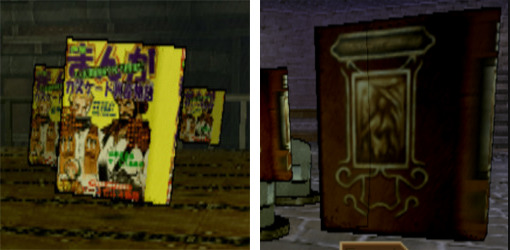

And finally* the rather goofy one time entry in Wild Arms 3, the Manga enemy --localized as Comic Book. It seems to feature the official character art of Dario and Romero ont he cover, with a feature highlight of Martina?
*I nearly missed Apocrypha being another WA3 original book enemy. It's pretty mundane recolor of the Bluebook, with a slightly different cover, but it's notably a neat sort of companion piece to Targum as another "biblical" text. Apocrypha are books of otherwise bible related or adjacent texts that aren't considered biblical canon, thus apocryphal texts. It's neat that the only two references to biblical texts that appear in the game with power are the original translations of the Tanakh and noncanon texts. Actual Christian new testament be damned.
And another really cool detail is that in the original Wild Arms, each book had its own unique interior texture as well, which could often barely be spotted during attacks



18 notes
·
View notes
Text
An ancient Aramaic translation of the Torah [Targum Yerushalmi] interprets the Hebrew word b’reishit (in the beginning) to mean behokhmah (with wisdom). According to this translation, the Torah opens with the statement, ‘With wisdom did God create the heavens and the earth.” A human being, by recognizing the vast wisdom of God as reflected in the universe He created, comes to a profund awareness of her relationship with God. Indeed, experiencing God as creator is the beginning of religious wisdom.
Moses Maimonides, the preeminent Jewish thinker of the Middle Ages, has understood this truth. He wrote:
Now what is the way that leads to the love of Him and the reverence for Him? When a person contemplates His great and wondrous acts and creations, obtaining from them a glimpse of His wisdom, which is beyond compare and infinite, he will promptly love and glorify Him, longing exceedingly to know the great Name of God, as David said: “My whole being thirsts for God, the living God” (Psalm 42:3). When he ponders over these very subjects, he will immediately recoil, startled, conceiving that he is a lowly, obscure creature... as David said: “As I look up to the heavens Your fingers made... what is man that you should think of him?” (Psalm 8:4-5).
The source of the love and fear of God rests in the contemplation of the world that God created.
— Rabbi Marc D. Angel, PhD, The Rythms of Jewish Living: A Sephardic Exploration of Judaism’s Spirituality
20 notes
·
View notes
Text


“You ascended to the expanse, o prophet Moses, you led captivity captive, you taught the words of the Law, you gave gifts to the sons of men.”
(5th-century Aramaic Targum: Psalm 68:18)
#my photography#my photographical world#my photography begins here#my photos#my photographs#new england outdoors#bible quote#summer 2024
1 note
·
View note
Text
Worthy Brief - April 22, 2024
Expect His coming!
Micah 4:8;5:2 And thou, O tower of the flock, the strong hold of the daughter of Zion, unto thee shall it come, even the first dominion; the kingdom shall come to the daughter of Jerusalem. But thou, Bethlehem Ephratah, though thou be little among the thousands of Judah, yet out of thee shall he come forth unto me that is to be ruler in Israel; whose goings forth have been from of old, from everlasting.
There are many who are not aware of the very deep significance of Bethlehem, Yeshua's (Jesus') birthplace. Everyone knows that Bethlehem was a place where shepherds grazed their sheep, and where the Messiah was to be born, but do not realize that it was a town designated as the birthing place for lambs which were used for the Passover sacrifice. The Scriptures give significant details about this little town lying slightly south of Jerusalem.
In Micah 4:8 we read about the "watchtower of the flock", or in Hebrew, "Migdal Edar." According to the "Life and Times of Jesus the Messiah", by Alfred Edersheim, a Jewish believer in the late 1800's, Migdal Edar was the location where the Messiah was to be revealed. This watchtower stood as a place of protection for the city from approaching enemies, but it was also utilized by shepherds to watch over the specific flocks from which sacrificial Passover lambs were taken.
The shepherds who were tending these particular flocks were no ordinary shepherds. They were specifically trained by the Rabbis for a holy task. They had to insure that, as much as possible, every lamb was free of any blemish or injury, in order to be used for the Passover sacrifice. Since they were instructed by the Rabbis, they almost certainly knew of those passages in the Targums (Aramaic translations) and the Mishna associating the birth of the Messiah with "Migdal Edar". For example, Migdal Edar is translated in one of the Targums as "The Anointed One of the Flock of Israel." It is also written in the Mishna that "He spread his tent beyond Migdal Edar, the place where King Messiah will reveal Himself at the end of days."
Pete, those shepherds had strong hints of Messiah's advent in the very town where they lived so that when the angelic host appeared announcing his arrival, they responded immediately and went to worship Him. We too have increasing signs of His soon Second Coming. Are we also prepared to respond? Our readiness to act in faith and worship will show how well we understand the signs of our own times. With so much work to be done, let us stay awake and be inspired by the expectation of his soon arrival – for, just like those shepherds of Bethlehem, we truly were born for such a time as this!
Your family in the Lord with much agape love,
George, Baht Rivka, Obadiah and Elianna (Dallas, TX)
(Baltimore, Maryland)
Editor's Note: Latest Video: Understanding Cycles, Freedom and Passover! - https://www.youtube.com/watch?v=MYxEvRYKItU
Editor's Note: During this war, we have been live blogging throughout the day -- sometimes minute by minute on our Telegram channel. - https://t.me/worthywatch/ Be sure to check it out!
Editor's Note: We are planning our summer Tour so if you would like us to minister at your congregation, home fellowship, or Israel focused event, be sure to let us know ASAP. You can send an email to george [ @ ] worthyministries.com for more information.
0 notes
Text
Berakhot 4b: 14. "The Glide."

14. I say: Because we have fixed Rabban "we have laid down" - as a similar redemption. Dai la tima hachi, shacharit hachi matzi semich? And Rabbi Yohanan said: At the beginning he says: "Lord, let my lips be opened", and at the end he says: "May the words of my mouth be to my will".
=
I say: Because we have fixed Moses, "we have laid down" as a similar redemption. Gliding is not the theme. That responsibility power offers support?
And the god Jonathan said "At the beginning he says: "Lord, let my lips be opened", and at the end he says: "May the words of my mouth be to my will".
The noun ραββονι (rabboni), which derives from רבן (raban), meaning chief teacher (MARK 10:51 and JOHN 20:16 only). This noun is also not used in the Old Testament but it does show up (in many variations and nuances) in the Aramaic Targum. The title רבנו (rabenu), or "Our Master" was bestowed on Moses. The term רבני (raboni) means My (Chief) Master.
During his audience with Ha Shem, the Burning Bush, Moses told God he did not think he was glib enough to lead the people of Israel to freedom. Even still he went before Pharaoh and insisted he end Slavery in Egypt.
God carried out every threat Moses made should Pharaoh refuse to release the people of Israel.
The transformation in Moses is the very same referred to by "the god of transition", as the one that causes boys to become men and full Royal Partners in the government. This verse is closely linked to v. 13, which discusses changes in the mind and body. Verse 14 speaks of the rites of manhood, citizenship, power and responsibility, which follow and not as a glide but as a climb.
The Values in Gematria are 10102, יאאֶפֶסב, Japheth.
"The verb פתה (pata) appears to describe the process of slowly but surely growing wider without investing much critical thought in the quality of the substance that is acquired.
It's the process that makes a mud flat or sand bank grow bigger, until it even begins to yield dry land and perhaps to support an island ecosystem. In much the same way a human mind will grow, if one does not separate useful from useless information, and eventually yield certainties and perhaps even forms of creativity that are all based on mostly garbage and loose debris.
This verb's sole derivative is the noun פתי (peti), which describes a non-critical mind that grows ever larger with nonsense: forever learning but never understanding."
Imagine if Moses just wanted to coast through life instead of trusting in God? We would not have any concept of freedom on this world at all. If we glide, the mind becomes soft and fat with nonsense. This will never result in Shabbat at the individual level, and cultures with too many fatheads in it will naturally not achieve Mashiach.
0 notes
Text
Abraham's wife Keturah in fact was the same woman Hagar

None of the commentaries questioned the legitimacy of the relationship between Abraham and Keturah.
BY RABBI KERRY M. OLITZKY
Commentary on Parashat Chayei Sara, Genesis 23:1 - 25:18
Following the death of his beloved Sarah, Abraham wed a second time. The Torah records it this way, “Abraham took another wife, whose name was Keturah” (Gen. 25:1). It is the Torah’s style only to add detail when necessary. Otherwise, it is up to the reader to discern the import of the Torah’s cryptic statements. In this case, there is no extensive discussion or lengthy debate. There is no explanation of Keturah’s lineage. Some suggest that she was Hagar. Others say that she was a different woman entirely.
Taking his lead from a variety of rabbinic sources, the great commentator Rashi boldly suggests that Keturah is Hagar: “She was called Keturah because her deeds were as pleasing as incense and because she tied up her opening [explanations emerging from two rabbinic folk etymologies on her name]; from the day she left Abraham, she did not couple with any man.”
Targum Yonatan, an Aramaic translation/commentary that is attributed to Yonatan ben Uziel, makes an even stronger statement to suggest that she was Hagar: “She was Hagar, who was bound to him from the start.” Perhaps she was indeed Hagar and perhaps Hagar was a woman of color. Some segments of the African American community, particularly women, have claimed Hagar as their own.
Others Disagree
Other commentators rejected the notion that Keturah was Hagar. But none questioned the legitimacy of the relationship between Abraham and Keturah. And that seems to be the most important lesson of this marriage. Keturah is a Cushite woman [of another religious background] (Numbers 12:1), a woman of color. Even the Rabbis who debate her identity have no argument here. They acknowledged long ago that there is room in the tent for all those who seek to enter it.
But there is more. According to the Midrash (Genesis Rabbah 61:6), in a comment on Genesis 25:5, Abraham thought to himself: “If I bless Isaac, (as the text suggests) then the children of Ishmael and of Keturah are included. But if I do not bless the children of Ishmael and of Keturah, how can I bless Isaac?” So he decided: “I am only human. I will fulfill my responsibility and whatever God wants to do, let God do it.” Consequently, when Abraham died, the Holy One of Blessing appeared to Isaac and blessed him. This implies that God affirmed Abraham’s blessing of the children of Keturah and of the children of Ishmael.
0 notes
Photo

Click to see a Word version of this Instagram post: ____ https://1drv.ms/w/s!Aon4q4RsUuHYhe9H7SE9FqrkeJ3qvA ____ „תּרְגּוּם“ Transliterated: ‘t͡ħarᵊɡ͡ħū́m’ Masculine noun. 1. ‘translation’; ‘the act of translating’; 2. Judaism specifically: ‘an Aramaic translation of the Bible’; ‘targum’. (Wiktionary definition) „פְּסַקוּ מִן קְרָבָא וְיֵדְעוּן אַרוּם אֲנָא יְיָ רָמָא בְּעַמַיָא רְמָא עַל יָתְבֵי אַרְעָא׃“ Psalm 46:10 Aramaic Targum Transliterated: ‘p͡ħəsaqū min qərāb͡hāʔ uəyē͡id͡hən͡gūn ʔărūm ʔănāʔ yəyā rəmāʔ b͡ħən͡gamayāʔ rəmāʔ n͡gal yāt͡həb͡hēiy ʔarən͡gāʔ.’ Translated: ‘Cease ye from war and know ye that I [am] Yahweh: I shall be exalted in the nations; I shall be exalted above the dwellers of the earth.’ My translation of Psalm 46:10 from the Aramaic Targum into Elizabethan English. ‘Cease (plural imperative) from war and know (plural imperative) that I [am] Yahweh: I shall be exalted in the nations; I shall be exalted above the dwellers of the earth.’ My translation of Psalm 46:10 from the Aramaic Targum into Modern English. ____ #targum #aramaic #jesus #judaism #history #ancientHistory #bible #christianity #education #language #languages #translation (at County Monaghan) https://www.instagram.com/p/CVoJehpsJ1C/?utm_medium=tumblr
#targum#aramaic#jesus#judaism#history#ancienthistory#bible#christianity#education#language#languages#translation
2 notes
·
View notes
Text
Guest on the Daily Dose of Aramaic Podcast
I was honored to be a guest on the Daily Dose of Aramaic show with Dr. Scott Callaham. It was an enjoyable wide-ranging conversation about the Targumim and kicks off their study of the Targumim and Targumic Aramaic. Be sure to go back and see his interview with Ed Cook.
youtube
View On WordPress
0 notes
Text
There is a new Bible translation, the Modern Standard Version. The Bible is an affirming translation.
A brief description appears below. The Bible can be purchased on both Barnes and Noble and Amazon. For your convenience, a link is provided to the Barnes and Noble website.
________
NEW - The worlds first affirming and inclusive Bible.
The Modern Standard Version is a complete translation of the Holy Bible in modern English. The Modern Standard Version is primarily that of the "equivalence" of a word for word translation. The Septuagint, the Dead Sea Scrolls, Samaritan Pentateuch, Syriac Peshitta, Aramaic Targum, Old Latin, Vulgate manuscripts, the Biblia Hebraica Stuttgartensia (5th edition.) and the Hebrew Tanakh was used to translate the Old Testament and correct the Masoretic Leningrad Codex. Critical texts are used to translate the New Testament instead of the Majority text that the ASV used. Thousands of archaic words and phrases have been updated and the MSV was checked against the Greek and Hebrew texts where there are significant textual variants or the meaning is not certain.
Anglo-Saxon words such as sin and Hell (which are not Hebrew or Greek words) have been replaced case by case with the proper English words. Also, there were six scriptures known as "the clobber scriptures" that have been used to hate, condemn and exclude the LGBTQ community. Those six passages have nothing to do with homosexuality. Yet, the reason why they claim to do those things is because they say they hate "sin". It's not sin they hate, it's homosexuals! They do not put forth the same kind of energy on anything else they call sin. Scripture should never be used to give people a license to become gatekeepers or modern day pharisees. The MSV is the worlds first truly inclusive and affirming Bible!
While you can go directly to either the Amazon or Barnes & Noble website and order the Bible, I was informed of an easier way.
Thank You can go to the Modern Standard Version website. On the website, you will find all of the formats of the Bible listed. You can click on the Bible you want and you should be directed to where you can purchase the book online. The website is https://www.msvbible.com.
#Bible#christian#lgbt#religion#Modern Standard Version#progressive christian#Bible translation#lgbtq#church#inclusive#inclusive Bible#gay Christian#lesbian christian#bisexual Christian#Trans Christian#bible translation#faithfullylgbt#pride Bible
102 notes
·
View notes
Text

Leopold Weiss (Muhammad Asad) was an Austro-Hungarian-born Muslim journalist, traveler, writer, linguist, political theorist, diplomat and Islamic scholar. Asad was one of the most influential European Muslims of the 20th century.
Leopold was born on 2 July 1900 to a Jewish family in Lemberg, Galicia, then part of the Austro-Hungarian Empire. He was a descendant of a long line of Jewish rabbis; however, his father, Akiva Weiss, broke from tradition and became a lawyer.
Leopold received a religious education and was proficient in Hebrew from an early age, as well as familiar with Aramaic. He studied the Jewish Bible or Tanakh, the text and commentaries of the Talmud, the Mishna and Gemara, also delving into the intricacies of Biblical exegesis and the Targum.

During his youth, Weiss developed an ever-deepening engagement with Islam. He finally embraced the faith in 1926 in Berlin, and went on to become one of the most famous Muslim intellectuals of the 20th Century, authoring a number of books on Islam, including his famous translation of the Holy Qur'an into English. He wrote:
"Islam appears to me like a perfect work of architecture. All its parts are harmoniously conceived to complement and support each other; nothing is superfluous and nothing lacking; and the result is a structure of absolute balance and solid composure."
237 notes
·
View notes
Text

I already sorta mentioned it in relation to the Adult Mag entry in the boss fight tournament, but it's fun to go over again,
BLUE BOOK is a fun reference to old English almanacs that implies a comprehensive collection of information, suitable for a magical autonomous book of magic.
NECRONOMIOCN taken famously from Lovecraftian lore, and a natural pick for a magical book enemy. Oddly despite the source material, it's not an especially threatening enemy in any of its appearances. Also it does not appear to be bound in human flesh, which is a shame because it could have made for a cool striking enemy model; although the pages of the WA1 model do have giant eyes in them.
TARGUM however is a much more obscure kind of reference. It's the term used to refer to the early translations of the Tanakh from their original Hebrew into Aramaic. I like the idea of it being used here to evoke a kind of ancient foreign magic of which this is the first comprehensible version of it written down for Filgaians. Also it's bound with a Japanese style sidestich rather than with a spine, giving a distinctly antique impression.
APOCRYPHA is a another fun one. Apocrypha can refer to a wide range of things in opposition to "canonical" texts. Probably most notable, or at least most familiar to people, would be the idea of biblical apocrypha; those biblical texts by subject and/or historical era not included in the bible itself, and considered by some to be heretical. It's neat as a magic tome as it implies something more secret, or rejected, or even forbidden.
DE RE METALLICA first appears not as an enemy at all but as the erroneously transliterated "De Le Metalica" dungeon, hidden within a magic book in Wild Arms 1, and subsequently Alter Code F. The real world De Re Metallica was a 16th century text written by Georg Bauer, cataloguing in 12 books all the details of how to find, mine, purify, smelt, and craft metal --a literally earth shattering development in mining and metalwork as it not only aggregated a long history of otherwise disparate and unwritten knowledge but also ventured into the then cutting edge of metallurgy and alchemy that would provide a groundwork for future developments in actual chemistry.
Then of course we have the ADULT MAG. Rather self explanatory, really. SUKEBEBONN[スケベ本]: "Lewd Book" in Japanese, it's a phrase that tends to refer to erotic manga more than the sort of adult photo collections we might think of in the west. In fact the first Dirty Mag model in WA3 actually has "ERO COM," as in "erotic comic", written on its cover. In fact something more in line with Hustler or Playboy would actually be referred to as a "Gravure" magazine.
The COMICBOOK which is again straight forward enough. It's just called MANGA in the original Japanese. If you're not familiar, Japanese serial manga are printed in magazine format, larger size, generally lower quality paper and print, but proportionally lower in cost as well(as little as the equivalent of 5.00USD for ~500 pages), but dozens of titles to an issue. Back when the Japanese and global economy were a little better, and when people still used phonebooks, they were often compared in size, although they tend to be a bit slimmer in recent years. In case it was odd to anyone why the comic book enemy was the size of a regular book. It's a shame this enemy didn't show up in other games.
and finally, STRATEGY GUIDE, which is a fun one. With Virginia and the title "WILD ARMS 3" on the cover. Another fun gag enemy with some 4th wall breaking fun for good measure. Again shame we never saw it make a comeback in any other games.


3 notes
·
View notes
Photo

The De Castro Pentateuch
With Haftarot and Five Scrolls
Scribe: Netanel [ben] Daniel (?)
Germany, 1344
Handwritten on parchment; dark brown and red ink, tempera, silver leaf; square and semi-cursive Ashkenazic script. L: 46; W: 31 cm
Commissioned by Joseph ben Ephraim for private use and public reading in the synagogue, this manuscript contains the Aramaic translation Targum Onkelos, as well as a hitherto-unknown version of the commentary of Rashi (Solomon ben Isaac, 1040-1105). The opening of each of the Five Books of Moses and the Five Scrolls is decorated with a large initial word and sometimes with an illustration, such as Adam and Eve in the Garden of Eden for Genesis. A full-page depiction of the hanging of Haman and his sons closes the book of Esther.
25 notes
·
View notes
Text
In Judaism, the Messiah is Destined to be Filled With Holy Spirit. Sounds Like Jesus' Concept, Doesn't It?
My journey began in 2012 when I studied Judaism and learned seriously Biblical Hebrew, Targum Aramaic, Syriac Aramaic, and Koine Greek. My goal is simple, if Jesus couldn't be proved in Judaism, then He was the false the Messiah because everything must be confirmed in Judaism.
My language skills in these 4 languages can be considered intermediate.
Read More
2 notes
·
View notes